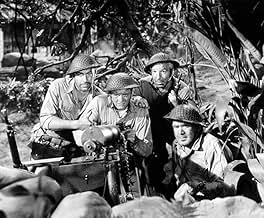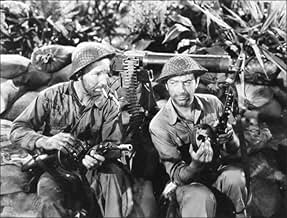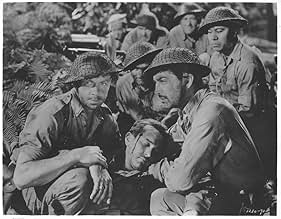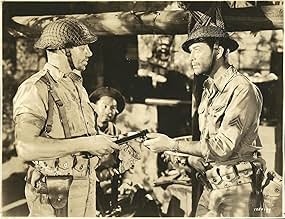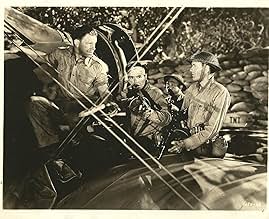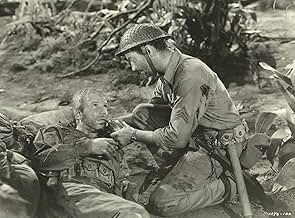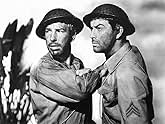IMDb RATING
6.9/10
2.9K
YOUR RATING
In 1942, in the Bataan peninsula of the Philippines, a ragtag American unit commanded by Sergeant Bill Dane attempts to blow-up a bridge in order to slow the Japanese advance.In 1942, in the Bataan peninsula of the Philippines, a ragtag American unit commanded by Sergeant Bill Dane attempts to blow-up a bridge in order to slow the Japanese advance.In 1942, in the Bataan peninsula of the Philippines, a ragtag American unit commanded by Sergeant Bill Dane attempts to blow-up a bridge in order to slow the Japanese advance.
- Director
- Writers
- Stars
- Awards
- 5 wins total
Alex Havier
- Yankee Salazar
- (as J. Alex Havier)
Ernie Alexander
- Wounded Soldier
- (uncredited)
Luke Chan
- Japanese Soldier
- (uncredited)
Wing Foo
- Japanese Soldier
- (uncredited)
Bud Geary
- Infantry Soldier
- (uncredited)
- Director
- Writers
- All cast & crew
- Production, box office & more at IMDbPro
Featured reviews
Robert Taylor gives a gritty performance as the leader of a thrown together unit fighting a delaying action during the fall of the Philipines. Lloyd Nolan does a good job as a professional soldier with a past, Thomas Mitchell is good as the older career soldier, perhaps a bit out of shape from years of peace time duty. Robert Walkers portrayal of a young homesick sailor is a good start on his career. This 1943 movie features some of the best hand to hand combat scenes to come out of any war movie, regardless of era. The exhaustion afterwards is strikingly realistic. This movie, dialogue included, is patriotic. At the time of Bataan, there wasn't much good news as the US had suffered some devastating defeats. The characters, regardless of race or creed, are treated equally which is a real plus for that time. I first saw this movie in a theatre when I was 9, (and yes, after the movie was over, the house lights came on and the ushers passed thru the audience selling War Stamps). I liked the movie then, and like it even more now. I give it a 9.
NOTE: A previous persons comment stated that they were not even wearing American helmets. In fact, the helmets worn in the movie ARE correct for the American Army in the early 1940's.
NOTE: A previous persons comment stated that they were not even wearing American helmets. In fact, the helmets worn in the movie ARE correct for the American Army in the early 1940's.
My Mom saw this movie at the time it was released and said it gave her more nightmares than any horror film she ever saw. It is still violent today and must have been shockingly brutal back in the day.
Yes, you can say some of the soldiers are clichéd, but death is shown unflinchingly. Combat is portrayed as a bloody, messy, fatigue-inducing business. Boredom and endless waiting take their toll on nerves as well. The banter and cocky talk is whistling past the graveyard.
Lloyd Nolan's character is rough and unlikeable. He fights for freedom, but he fights dirty and he doesn't pretty things up with patriotic speeches. Some might complain about the black soldier playing harmonica and taking orders from white men. Actually, for the time, he was portrayed with dignity and shown to be as brave as any of the other soldiers. As for Robert Taylor, his weariness and resolve at the end are stirring and the last scene is not one you will soon forget.
Ignoring the propaganda aspects of the movie, the last half works as almost a pure horror movie, as our cast gets gruesomely picked off by unseen foes lurking in the jungle.
Exciting and gripping, it's easy to overlook the faults of this most violent and gritty of WW2 films made at the time.
"Bushido, Bushwa! You stink!" So died the heroes of Bataan...
Yes, you can say some of the soldiers are clichéd, but death is shown unflinchingly. Combat is portrayed as a bloody, messy, fatigue-inducing business. Boredom and endless waiting take their toll on nerves as well. The banter and cocky talk is whistling past the graveyard.
Lloyd Nolan's character is rough and unlikeable. He fights for freedom, but he fights dirty and he doesn't pretty things up with patriotic speeches. Some might complain about the black soldier playing harmonica and taking orders from white men. Actually, for the time, he was portrayed with dignity and shown to be as brave as any of the other soldiers. As for Robert Taylor, his weariness and resolve at the end are stirring and the last scene is not one you will soon forget.
Ignoring the propaganda aspects of the movie, the last half works as almost a pure horror movie, as our cast gets gruesomely picked off by unseen foes lurking in the jungle.
Exciting and gripping, it's easy to overlook the faults of this most violent and gritty of WW2 films made at the time.
"Bushido, Bushwa! You stink!" So died the heroes of Bataan...
I remember seeing this film as a child, but only recently did I get a copy of the DVD and experience it as an adult. Being a student of history and in the military, war films have to go a long way to impress me. This one doesn't let you down. In some ways I think it does a better job realistically portraying war than some modern films I've seen. This small patrol of US Army soldiers must contend with lethal sniper fire, air raids, and overwhelming numbers of Japanese soldiers. One other thing it does a good job at is fully representing the diverse social spectrum of our country. For a film made in 1943, that is quite an accomplishment. Bravo!
I first saw this film about 20 years ago and absolutely loved it. When I purchased the film recently, I can still say I absolutely love it. Of course when seeing the film today, the viewer may think that this film is a bit anachronistic, especially considering todays jaded skepticism and mentality of "question everything, trust no one". But given the year when the movie was made (1943) it falls right in line with the mindset of the times. The acting and sets are pretty much of the standard 30's and 40's Hollywood flair with the bad guys being very bad, the good guys being very good and those that die in battle doing such without much complaint or bloodshed. But all aside, I was able to get drawn into the characters lives to the point to where I was concerned with who lived and who died as well as being on the edge of my seat with all the ensuing tension that only a good war picture can give. All in all, I would rate this film a must see. No, this film won't deliver the intense realism as does Band of Brothers or Saving Private Ryan but it also doesn't deliver the always painful to watch introspective/flashback ponderings that Thin Red Line does. Another plus is that there ISN'T a love story plunked down in the middle of the story line!
BATAAN is one of the better war films to come out during the war years of World War II. Robert Taylor holds the whole gritty film together with his realistic depiction of a sergeant leading a small troop of men in an effort to hold back the Japanese attack by blowing up a crucial bridge. Taylor, Robert Walker as a gum-chewing homesick sailor, Lloyd Nolan, Dezi Arnaz (surprisingly effective in a dramatic role) and others make splendid contributions. Special mention should be made of Philip Terry's medic--an under-appreciated actor who is shown as committed to his job in a selfless way but finally going berserk under the pressures of war. (He had other good roles in Olivia de Havilland's TO EACH HIS OWN and Ray Milland's THE LOST WEEKEND).
The jungle setting (although filmed on the studio lot) is impressive with its exotic foliage and adds to the realism. The hand to hand combat scenes are well staged, as are the final moments of the film.
All in all, a gripping war film that more than holds its own with contemporary stories like SAVING PRIVATE RYAN.
Has to be appreciated in the context of its time--when flag-waving patriotism was at its peak and lines like "Those dirty Japs" were not considered politically incorrect.
The jungle setting (although filmed on the studio lot) is impressive with its exotic foliage and adds to the realism. The hand to hand combat scenes are well staged, as are the final moments of the film.
All in all, a gripping war film that more than holds its own with contemporary stories like SAVING PRIVATE RYAN.
Has to be appreciated in the context of its time--when flag-waving patriotism was at its peak and lines like "Those dirty Japs" were not considered politically incorrect.
Did you know
- TriviaPrologue: "When Japan struck, our desperate need was time--time to Marshall our new armies. Ninety-six priceless days were bought for us--with their lives--by the defenders of Bataan, the Philippine army which formed the bulk of MacArthur's infantry fighting shoulder to shoulder with Americans. To those immortal dead, who heroically stayed stayed the wave of barbaric conquest, this picture is reverently dedicated."
- GoofsAlthough the American soldier was clearly a great coconut tree climber, it is near to impossible to sit atop a coconut tree. Many Filipinos to this day fall when attempting this.
- Quotes
Sergeant Bill Dane: Come on, suckers! What's the matter with you? What are you waitin' for? Didn't think we were here, did you? You dirty rotten rats! We're still here! We'll always be here! Why don't you come and get it?
- Crazy creditsClosing credits epilogue: So fought the heroes of Bataan. Their sacrifice made possible our victories in the Coral and Bismark Seas, at Midway, on New Guinea and Guadalcanal. Their spirit will lead us back to Bataan!
- Alternate versionsAlso available in a computer colorized version.
- ConnectionsFeatured in Toast of the Town: A Salute to Lucy and Desi (1954)
- SoundtracksSt. Louis Blues
(1914) (uncredited)
Music and Lyrics by W.C. Handy
Sung a cappella and hummed often by Kenneth Spencer
- How long is Bataan?Powered by Alexa
Details
Box office
- Budget
- $958,000 (estimated)
- Runtime
- 1h 54m(114 min)
- Color
- Aspect ratio
- 1.37 : 1
Contribute to this page
Suggest an edit or add missing content


